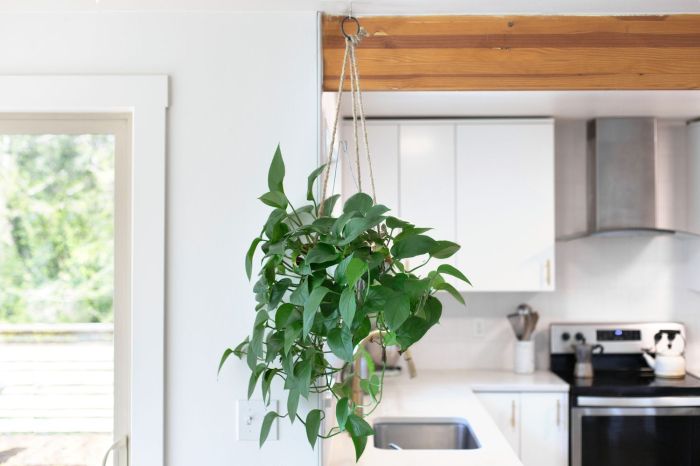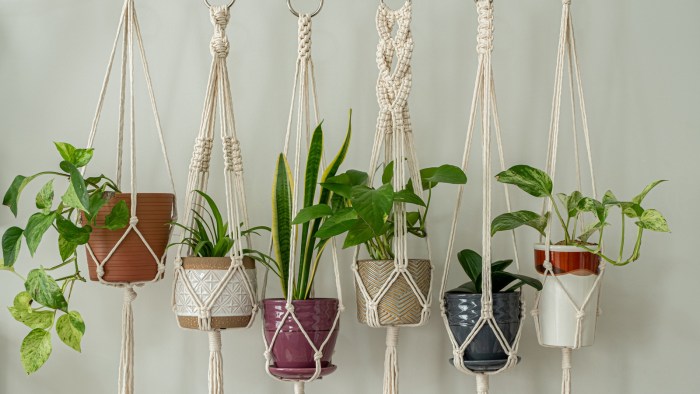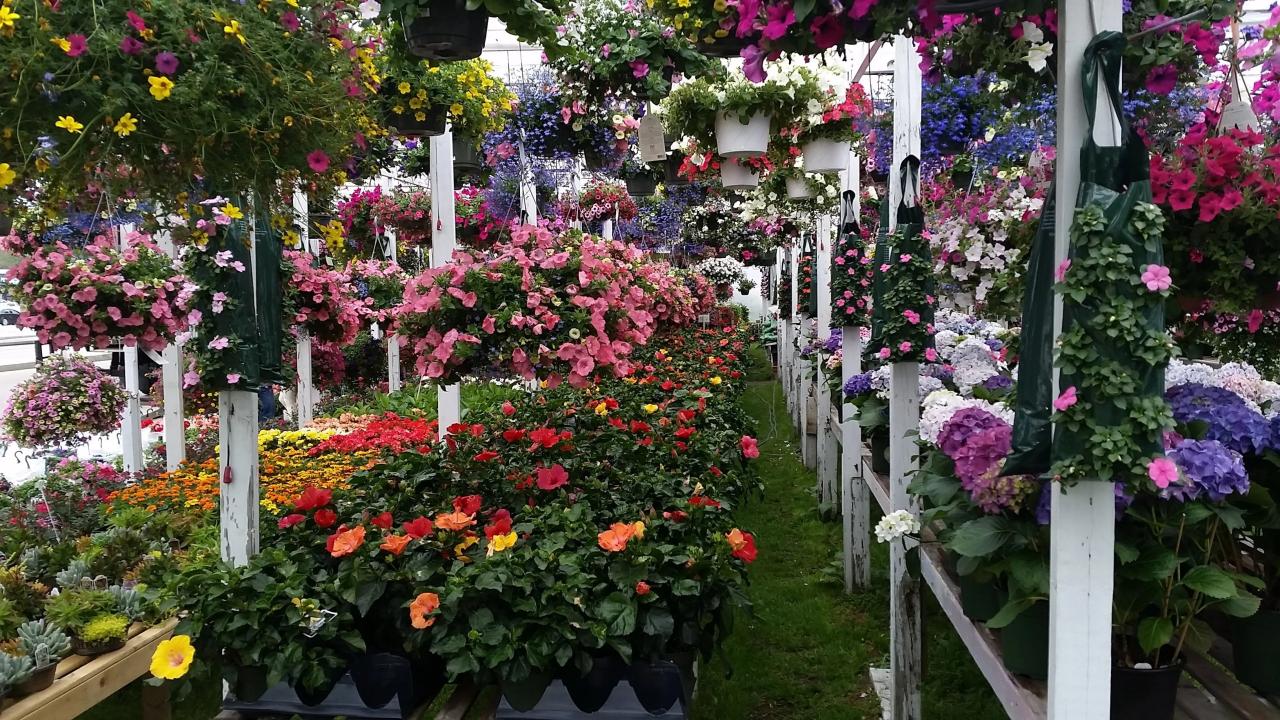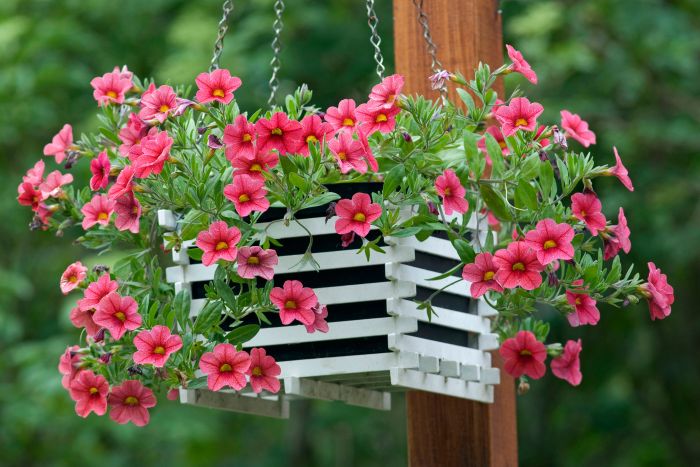Transform your indoor and outdoor spaces with the effortless charm of easy to care hanging plants. These low-maintenance wonders bring a touch of greenery and elegance to any setting, creating a vibrant and inviting atmosphere.
From lush ferns to trailing succulents, discover the best hanging plants that thrive with minimal effort, providing year-round beauty and tranquility.
Popular Easy-Care Hanging Plants

Hanging plants bring a touch of greenery and life to any space, and they’re especially well-suited for those with limited floor space. But not all hanging plants are created equal. Some are more forgiving than others when it comes to care, making them ideal for busy people or those who don’t have a green thumb.
Here are a few of the most popular easy-care hanging plants:
Spider Plant (Chlorophytum comosum)
- Spider plants are known for their long, trailing leaves that produce plantlets, or “spiders,” at the ends.
- They’re very tolerant of neglect and can survive in a wide range of light conditions, from bright indirect light to low light.
- Spider plants also prefer well-draining soil and moderate watering.
Pothos (Epipremnum aureum)
- Pothos is another popular hanging plant with trailing vines and heart-shaped leaves.
- It’s known for its hardiness and can tolerate low light and infrequent watering.
- Pothos prefers well-draining soil and can be fertilized monthly during the growing season.
Philodendron (Philodendron spp.)
- Philodendrons are a large genus of plants with many different species that are suitable for hanging baskets.
- They typically have large, glossy leaves and can tolerate a range of light conditions, from bright indirect light to low light.
- Philodendrons prefer well-draining soil and moderate watering.
String of Pearls (Senecio rowleyanus)
- String of pearls is a unique hanging plant with trailing stems covered in small, round leaves that resemble pearls.
- It’s a succulent that prefers bright indirect light and infrequent watering.
- String of pearls should be planted in well-draining soil and fertilized sparingly.
Burro’s Tail (Sedum morganianum)
- Burro’s tail is a succulent with trailing stems covered in plump, cylindrical leaves that resemble a burro’s tail.
- It prefers bright indirect light and infrequent watering.
- Burro’s tail should be planted in well-draining soil and fertilized sparingly.
Choosing the Right Hanging Basket
When choosing a hanging basket for your plant, consider the plant’s size and growth habit.
Hanging plants add a touch of greenery and freshness to any indoor space. If you’re looking for low-maintenance options, consider the easiest hanging plants indoor . These plants are not only beautiful but also incredibly easy to care for, making them perfect for busy individuals or those new to plant care.
- For small plants with trailing vines, such as spider plants and pothos, a small to medium-sized basket is ideal.
- For larger plants with upright growth habits, such as philodendrons, a larger basket with a sturdy frame is necessary.
Also, consider the material of the basket. Plastic baskets are lightweight and easy to clean, while metal baskets are more durable and can add a touch of style to your space.
For home gardeners seeking easy-to-care hanging plants, look no further than Hanging Plants Indoor . Their website offers an extensive selection of low-maintenance hanging plants that can add life and greenery to any indoor space. Whether you’re a novice or an experienced plant enthusiast, their website provides valuable tips and advice on choosing and caring for these versatile plants.
Ideal Growing Conditions: Easy To Care Hanging Plants

Providing the right growing conditions is crucial for thriving easy-care hanging plants. These plants prefer specific light, water, and temperature conditions to flourish and maintain their beauty.
Light Requirements, Easy to care hanging plants
Most easy-care hanging plants thrive in bright, indirect sunlight. They prefer locations that receive several hours of sunlight each day, but not intense direct sunlight, which can scorch their leaves.
For those seeking low-maintenance greenery, easy-to-care hanging plants offer a convenient and stylish solution. Among these, the draping shelf plant stands out for its ability to cascade gracefully over shelves or furniture, adding a touch of natural elegance to any space.
Whether you’re a seasoned plant enthusiast or a novice gardener, these easy-care hanging plants are sure to bring joy and tranquility to your home.
Watering Techniques
Proper watering is essential for the health of hanging plants. Allow the soil to dry out slightly between waterings, and avoid overwatering, as this can lead to root rot. Water thoroughly until excess water drains from the pot.
Temperature and Humidity
Easy-care hanging plants generally prefer warm temperatures between 65-80°F (18-27°C). They also benefit from moderate to high humidity levels, which can be achieved by misting the plants regularly or placing them on a tray filled with pebbles and water.
Many easy to care hanging plants are also trailing house plants, meaning they can be grown in hanging baskets or pots and allowed to trail down. This can create a beautiful and lush look, and it can also be a great way to save space in your home.
If you’re looking for an easy way to add some greenery to your home, consider choosing a few easy care trailing house plants . They’re a great way to add some life to your home without having to put in a lot of effort.
Essential Care Tips

Maintaining the health and beauty of easy-care hanging plants requires a few essential care tips. Fertilizing, pruning, and pest and disease management are crucial for optimal growth and longevity.
Fertilizing
Fertilizing provides nutrients for hanging plants to thrive. Choose a balanced, liquid fertilizer and dilute it to half strength. Apply it monthly during the growing season (spring and summer) and reduce frequency during fall and winter.
Pruning
Pruning helps shape hanging plants and encourages new growth. Use sharp, clean shears to remove dead or damaged leaves and stems. Pinch back leggy stems to promote bushier growth.
Common Pests and Diseases
Hanging plants may be susceptible to common pests and diseases. Inspect plants regularly for signs of infestation or infection. Use insecticidal soap or neem oil to treat pests. For diseases, remove infected plant parts and adjust watering practices to prevent overwatering.
Design Considerations

Hanging plants offer a versatile and visually appealing way to add greenery to any space. By incorporating different colors, textures, and foliage types, you can create stunning arrangements that complement your décor and enhance the ambiance of your home.
Hanging plants can be used to add height and interest to a space. They can be suspended from the ceiling, hung on walls, or placed on shelves or tables. In outdoor spaces, hanging plants can be used to create privacy screens, define areas, or add a touch of greenery to patios and balconies.
Mixing Colors, Textures, and Foliage Types
When choosing hanging plants, consider the colors, textures, and foliage types of the plants you select. Mixing different colors can create a vibrant and eye-catching display. For example, you could pair a trailing plant with variegated leaves with a plant with solid green leaves.
Different textures can also add interest to an arrangement. For example, you could combine a plant with soft, velvety leaves with a plant with stiff, spiky leaves.
Incorporating Hanging Plants into Various Spaces
Hanging plants can be used to add a touch of greenery to any space. In living rooms, they can be used to create a focal point or add height to a corner. In bedrooms, they can be used to create a relaxing atmosphere.
In kitchens, they can be used to add a touch of freshness and brighten up the space.
Benefits of Using Hanging Plants
Hanging plants offer a number of benefits, including:
- They can add height and interest to a space.
- They can be used to create privacy screens or define areas.
- They can help to improve air quality.
- They can be a great way to add a touch of greenery to a small space.
Troubleshooting Common Issues

Easy-care hanging plants can sometimes encounter problems, but with proper identification and treatment, they can be restored to health.
Common issues include yellowing leaves, stunted growth, and pests. Yellowing leaves can indicate overwatering, underwatering, lack of sunlight, or nutrient deficiencies. Stunted growth can be caused by lack of light, insufficient nutrients, or rootbound conditions.
Pests
- Aphids are small, soft-bodied insects that can infest plants and suck their sap. They can be controlled with insecticidal soap or neem oil.
- Mealybugs are small, white, cottony insects that can also infest plants and suck their sap. They can be controlled with rubbing alcohol or horticultural oil.
- Spider mites are tiny, spider-like creatures that can infest plants and cause their leaves to turn yellow and drop off. They can be controlled with insecticidal soap or neem oil.
Closing Notes

Embrace the beauty of easy to care hanging plants and elevate your living spaces with their effortless charm. These versatile plants offer endless possibilities for creating lush, verdant displays that enhance the ambiance of any home or garden.
Questions Often Asked
What are the most popular easy to care hanging plants?
Spider plants, pothos, ferns, succulents, and trailing begonias are all popular choices for their hardiness and low maintenance requirements.
How often should I water my hanging plants?
Water your hanging plants when the soil feels dry to the touch, typically once or twice a week.
What is the best way to fertilize hanging plants?
Use a balanced liquid fertilizer diluted to half strength and apply it once a month during the growing season.